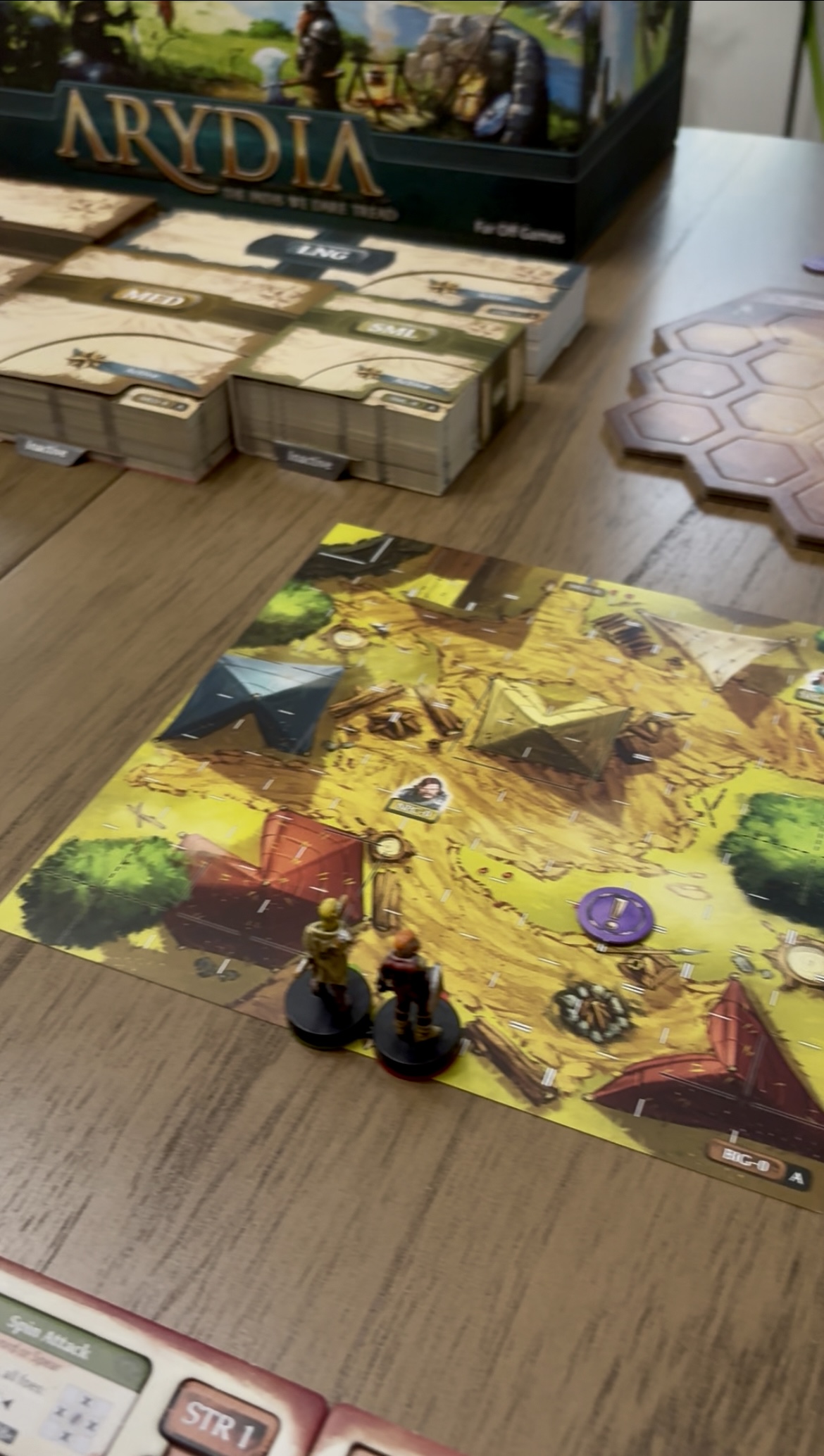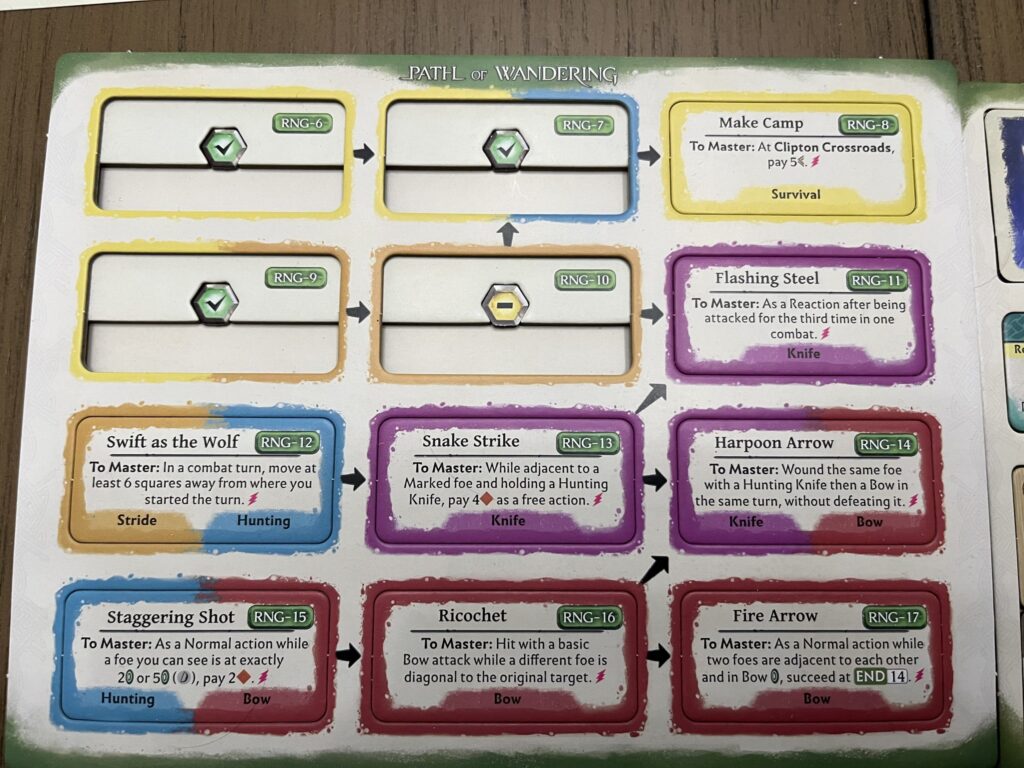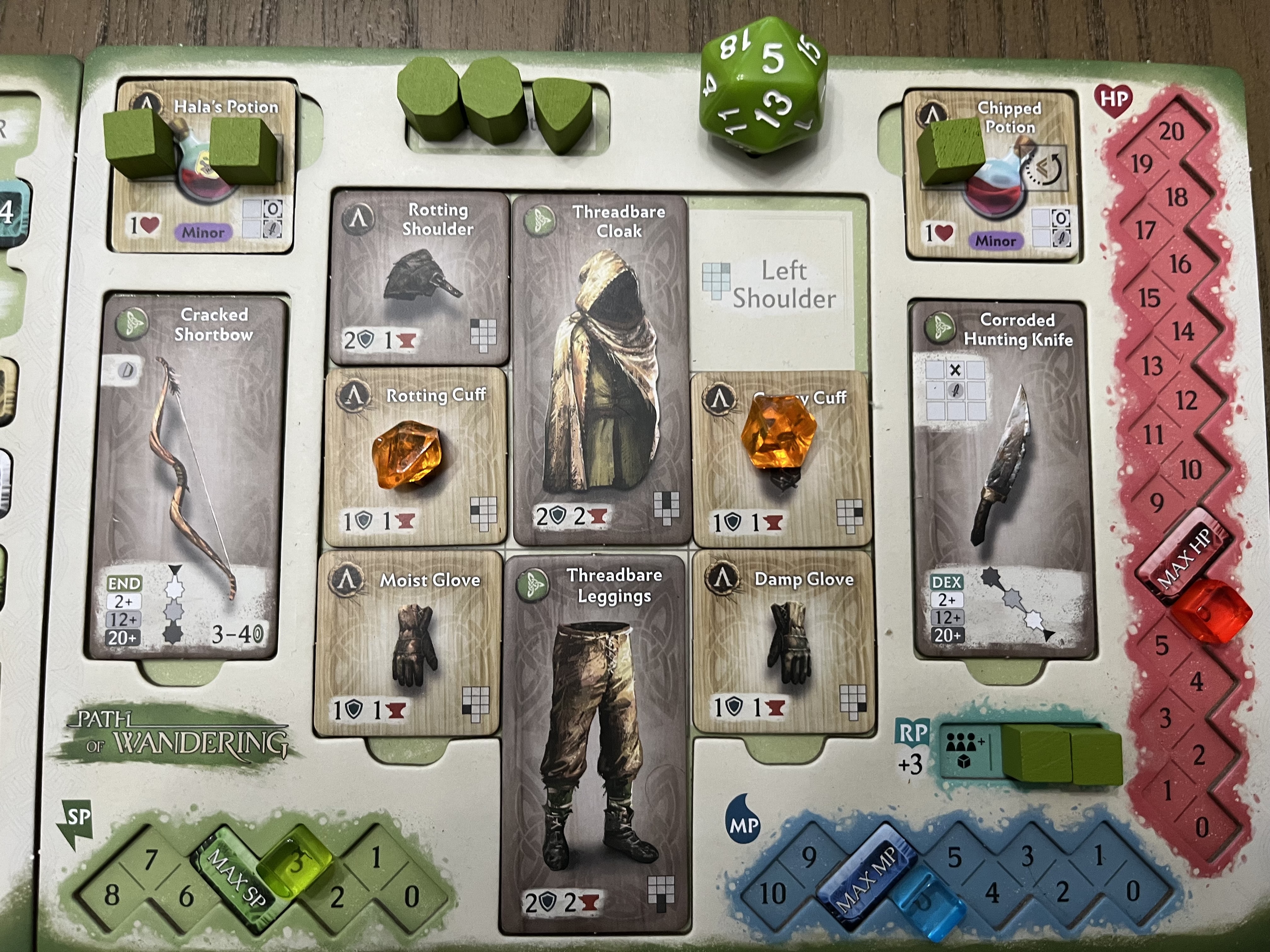Welcome to this week’s review! This week I’m taking a look at one of my favorite cooperative games and likely my favorite open-world, adventure game. Since exploration and discovery are a large part of the game, I will try to keep this review as spoiler-free as possible. So without further ado, let’s jump into it.
Disclosure: A review copy of this game was provided to The Meeple Digest in exchange for an honest, unbiased review. This review is not intended to be an endorsement.
Arydia: The Paths We Dare Tread
- Designers: Cody Miller, Ira Fay
- Publisher: Far Off Games
- Complexity: Medium
- Time: 60-240 Minutes
- Players: 1-4
- Main Mechanisms: Open World, Adventure
One of my favorite video games is Baldur’s Gate 3, and Arydia is the closest a board game has come to replicating that feeling. Effectively Dungeons & Dragons (D&D) in a box, Arydia is a mix between an adventure game like Sleeping Gods and a dungeon-crawler like Gloomhaven.

Arydia is a “green legacy” campaign game for one to four players, which means that there are many of the hallmarks of legacy games with plenty packages to open and discovery along the way, while also being fully resettable. Where a campaign of Sleeping Gods might take you roughly 10-12 hours to complete, Arydia’s campaign will likely take upwards of 60 hours to finish.
One of the brilliant inclusions for Arydia is the quick start guide. Rather than needing to read the entire rulebook before jumping in, the quick start guide effectively acts as the game’s tutorial. The guide allows you to start playing the actual game, while teaching you all of the important mechanics as you play. There are even separate combat guides for each of the character classes that walk you through a combat encounter. Overall, the quick start guide made the game easier to approach and learn.
When you start a campaign, the first thing you get to do is create your own character. There are six different paths, which take inspiration from traditional D&D classes like the Fighter, Ranger, and Cleric. In addition, there are nine playable Characters that act as the different races. For my first campaign, I chose a very traditional party with a Dwarf-Fighter and an Elf-Ranger, but you are also free to mix and match classes and races to your heart’s content.
Without giving too much away, the game’s storyline is that your characters are exiles who need to collect “Squills”, which are earned by completing quests, to return home. At the beginning of the game, you aren’t given much information on why your characters are exiles; however, as you progress, you receive snippets of the information on your backstory based on your chosen race. I found this discovery much more exciting and impactful than if I had received the same information from the start.
The majority of the gameplay involves your traditional open-world activities, such as traveling to locations, talking to NPCs, and fighting foes. In order to facilitate these activities, the game uses an excellently designed index system for its maps and cards. The world map uses a hex grid system, and when you travel to a new hex, often that location can be explored, which is done by finding the corresponding map tile as specified on the hex. Once you start exploring a map, there are often connecting maps that can further be explored from the same location. As I started playing, I was amazed by the overall scope of the world that seemed to keep growing larger as I progressed through the campaign.
In addition, often maps will show NPCs or events, which are resolved by drawing the corresponding card from their deck. As you progress, you’ll often be instructed to banish cards, effectively removing them for the rest of the game, as well as swap cards out with alternative versions. For example, you might meet an NPC, but later after fulfilling their quest, that NPC will change, which is done by replacing that version of the card in the index. This makes the game feel like it evolves based on your actions. Speaking of, if you weren’t convinced that the campaign might take 60+ hours to complete, for context, there are 1000+ cards and 300+ maps.
The character progression system is also very rewarding. As you play, you acquire items to enhance your character, such as healing potions and better weapons and armor. Completing combat encounters and quests also reward your party with experience points that are required to level up your character. Any time your character levels up, you get to choose to increase one of their stats (health, stamina, mana), increase one of their attributes (strength, dexterity, etc.), and learn a new skill. One interesting design decision was that whenever you level up a stat or attribute, it automatically increases the value of that stat to the maximum amount for that level. For example, say one of your character’s strength is currently at a one, when you reach level four and choose to increase strength, it would increase to a five. Traditionalists may feel this system is too forgiving, but I personally enjoyed the flexibility. Typically, you’ll want to focus more on stats and attributes that work well with your playstyle, skills, and weapons, but every once and a while I would pick an attribute to level up that my party was particularly weak in to create balance.



Speaking of stats, the combat system feels very streamlined, which plays out on maps similar to a dungeon-crawling game. Effectively, combat turns alternate between a character and the foes, so the foes will take a turn, then character one, then foes again, then character two, and so on. Each type of foe has their own set of actions, which is determined by a combat deck and the threat level. For example, certain combat cards will increase the threat level and/or instruct certain types of foes to act, which is done by reducing the threat level counter by the maximum amount possible as specified on the foe card. Higher levels of threat typically modify the foe’s actions, such as by increasing the amount of damage dealt. In order to defeat an enemy, the game uses a similar grid system as in Sleeping Gods. You will need to cover up all of the hit points on the enemy card in order to defeat it. Characters can deal damage to foes by using equipped weapons, which each have their own attack pattern and skill checks. Overall, the combat system felt very streamlined, while still allowing for plenty of tactical decision-making.
Playing Arydia solo also works surprisingly well. I chose to control two characters during my solo campaign, and once I got going, it was very easy to manage. Comparing it to the original Sleeping Gods which is a bit of a nightmare to control nine characters solo, managing two characters solo in Arydia is a breeze. The game also allows you to adjust the number of players at any point, so you are never locked in to certain player count. There are some roll-playing elements that you won’t get to experience as much playing solo, but considering the game’s length, realistically, I’ll personally have a much greater chance of finishing the campaign solo than if I played it largely as a multiplayer game. I wouldn’t mind having others sit in for some sessions though if they wanted to try the game. As I mentioned though, if you wanted to run a solo campaign with more or less characters, there’s flexibility as the leveling system makes true-solo feel equally doable.
Now moving to a couple of slight nitpicks. First off, the game can sometimes feel like you’re encouraged to follow a somewhat linear path. In Sleeping Gods, you’re often allowed and encouraged to explore, whereas in Arydia, if you stray too far from the designed path, the game can feel quite punishing. For example, once I got through the quick start guide, I decided to go off in a certain direction. Fairly soon, I wandered into an enemy encounter where the enemies were four levels higher than my characters. For reference, the game suggests that foes who are two or more levels above your level will be very tough. I ended up fleeing that combat and going back in the direction the game initially suggested, but these sort of moments happened a couple times throughout my campaign when I would try to explore on my own. I understand that a lot of this is determined by the design of enemy scaling, which is something that a lot of open world games struggle with. In Arydia, the enemies are a fixed level rather than scaled based on party level, and overall, I found the majority of the combats struck a nice balance of being challenging, without overly punishing players (provided you are able to keep to combats with enemies near your level). If I were to guess, I’m likely a third of the way through the campaign, so I’ll be interested to see if the game starts to open up a bit more. There are a ton of optional quests though, so you’re not forced to see everything in one campaign.
Next, whenever you travel on the world map between hexes, you are required to draw from an exploration deck. One of my favorite parts of this system are the random encounters. Over the course of the game, you’ll be instructed to add cards to the exploration deck, usually as a result of finishing certain quests. Later when you’re exploring, you may run into those characters again as a result of drawing a card from the exploration deck. Overall, I loved this system; however, if I were to nitpick, later in my campaign, I found myself having to double back to certain locations, and in that case, the exploration deck became a bit more tedious. Speaking of, be sure to keep notes as you go to avoid having to revisit certain locations because some cards will require you to find other cards with a certain text in order to complete. This also comes in handy between sessions to remember any plans you had.
I’m always amazed at how these enormous, campaign-style games get made. The level of detail that went into crafting the world and components is truly stunning. This review is already quite long, and I have yet to mention some of my favorite touches like the pre-painted miniatures, how you get to assemble your character figure, or even how many of the cards have rules FAQs on the back. I understand that undertaking a massive campaign game like Arydia is quite the time and financial investment for gamers; however, playing through Arydia has been a true highlight in my board gaming journey, and I’m looking forward to seeing my campaign through to completion because of how much fun I’ve had so far. Arydia is already one of my favorite cooperative games, and it’s also making a strong case to be one of my favorites of all-time.
With that, I’ll wrap up this week’s review! If you’ve played Arydia, I’d love to hear your thoughts on the game? And what are some of your favorite campaign games? I’d love to hear your thoughts on any of the games I’ve mentioned or future content suggestions in the comments below. Happy gaming!
If you liked this post and want to be notified when new content is released, then follow me on Instagram @themeepledigest.
